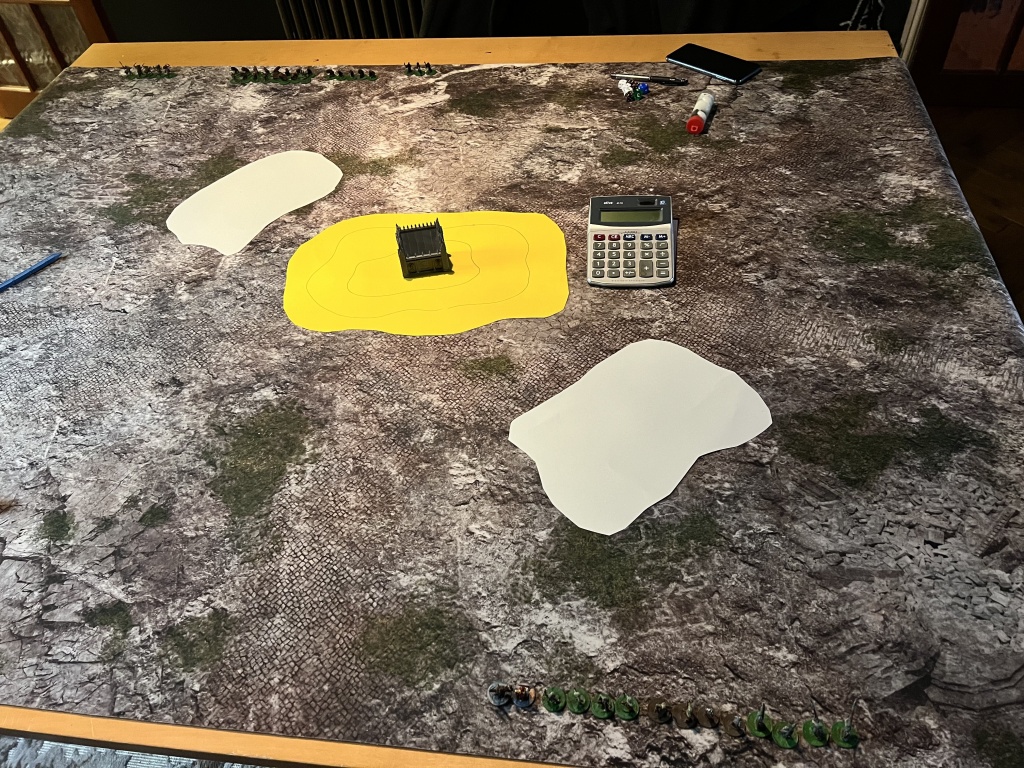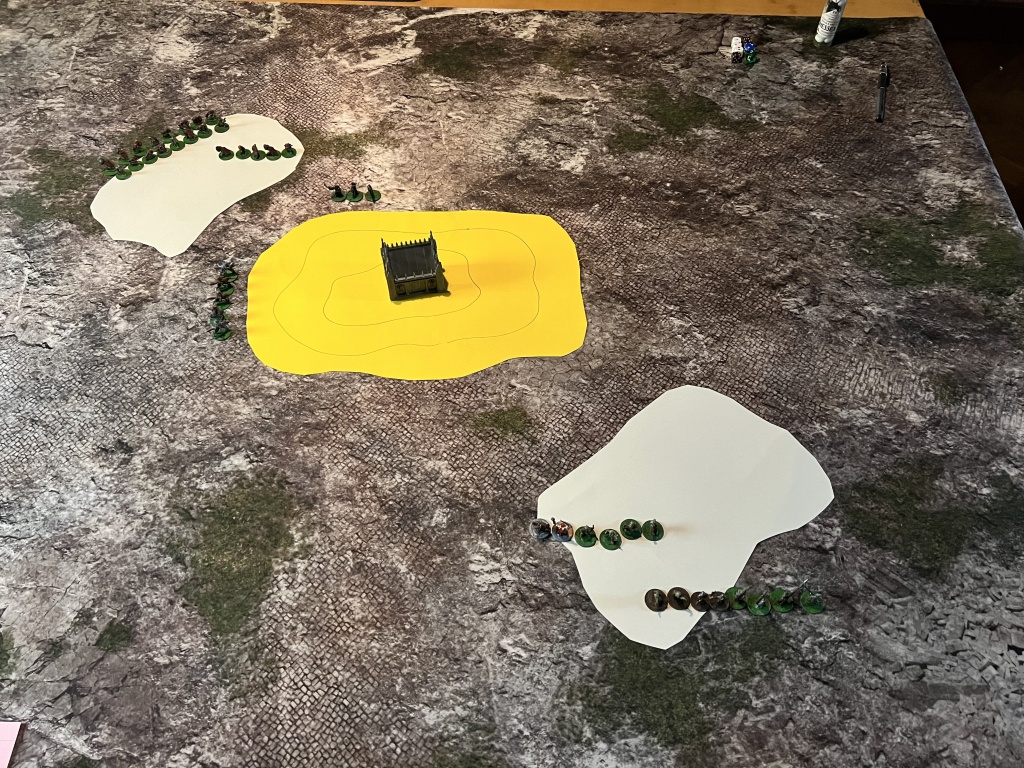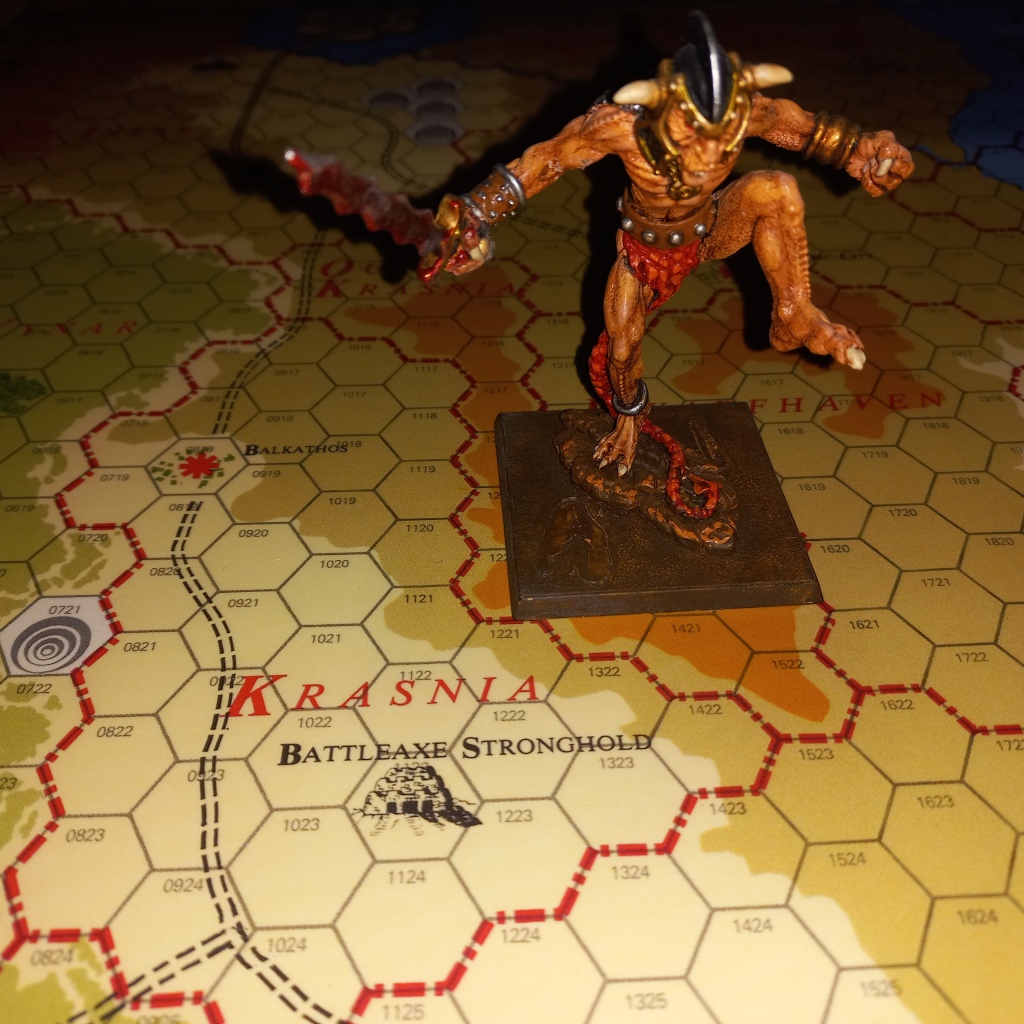I’ve been fascinated by the various methods Dungeon Masters use to tackle mass battles for some time, from hand waving them as a background event to the use of one roll resolutions like BECMI’s Warmachine. I’ve always been most interested by the use of miniature figures and wargaming rules to resolve these battles, having originally come into table top gaming by way of Warhammer Fantasy Battles.
So, several months ago, I made a conscious decision to try out all the various war gaming rules I’ve seen recommended for Advanced Dungeons & Dragons (my current rules set) until I find one that best suits my current campaign and tastes.
I have currently played through the introductory scenarios in the 1E Battlesystem supplement solo and found it has some interesting mechanics and integrates well with standard Ad&d play, but the attack resolution mechanic is just a bit too bloated for me – it has a massive table that to use you must first calculate an Attack Rating, and then do arithmetic each attack and search through the many rows to find the casualty number. Not too bad really, but after a couple of rounds of play it becomes tedious and saps the excitement out of the game.
After that I set out to try all the other methods; Chainmail, Swords & Spells, Delta’s Book of War, and regular Ad&d combat resolution scaled up.
This week one of my players was unable to make my regular game, and so with two fistfuls of painted minis I set up a battle for my two players, and we did a bit of play testing; player vs player with me judging.
This is a write up of that game, and a description of how I ran it.

The Armies
I decided to roll up two humanoid forces using the 1e Monster Manual. My reasoning was that if I want to use wargaming rules in my campaign there would be plenty of asymmetric armies cropping I play. The random generation method of the MM seemed a good way to test how Chainmail handles such unbalanced battles.
I opted to use Wood Elves vs Goblins and rolled up their numbers and weaponry as if it were a random encounter in the wilderness. Then I had to make conversions, matching up weapons, and lumping the forces into sets of 1:10 for their model ratios.
Partially the reason I chose these two monsters was because in Chainmail one is clearly superior to the other. I decided to make large changes to the way they present in Chainmail rules, and have them more in keeping with the statistics found in the Monster Manual. More on these changes later.
Goblins
- 200 goblins with spears and slings – 20 Light Foot models with spear and sling
- 50 wolf riding goblins armed with morning-star – 5 Light Horsemen with morning-star
- 30 strong goblins (orc) with swords – 3 Heavy Foot
Elves
- 40 wood elves with bows (and sword) – 4 Archers
- 40 wood elves with spear – 4 Heavy Foot
- 2 Fighter Lvl 1
- 2 Fighter Lvl 2
- 2 Fighter/MU Lvl 2/1
Rule Changes
My plan is to play this as if it were in an Ad&d campaign. The rules in Chainmail are not really fit for purpose as given. Most obviously, the Chainmail rules were written before 1e, and the abilities for these creatures were both vastly changed by 1978. Some of the strange differences found in Chainmail include Goblins hitting as Heavy Foot but defending as Light Foot, and all elves constantly being invisible and all carrying magic swords. These are rules designed to counter other fantastical beasts in the Fantasy Supplement, and they have no use for me.
These are the main rule changes I made:
- Goblins are light foot.
- Elves fight and move as they are armed; spearmen are Heavy foot, and bow wielders are Archers.
- Classed NPCs fight and move as per the rules found in Anthony Huso’s updated cheat sheet for chainmail, which I believe uses material from Delta Book of War.
- Elves can split move and fire.
- Elves are invisible until they first attack, but not after that. This follows how they are written in the monster manual where they are able to blend in with grass and trees until they attack.
- I am using simultaneous initiative for this game, which means the two players write down their orders and I adjudicate the moves as if they were concurrent.
- I use the alternative rule for Morale, pg. 17 Chainmail; Instability Due to Excess Casualties.
- Spells are identical to how they are found in Ad&d, and so only as effective as they might if all the men were individual tokens. These spells take effect in the Artillery phase.
- Slings are the same as found in Ad&d RAW: 20″ range, ROF 1.
- No measuring allowed by players.
- I changed the turn order to this:
1. Write Orders
2. Simultaneous Movement (passing fire, split fire)
3. Artillery (magic)
4. Simultaneous ranged attacks
5. Melee in weapon speed order.
6. End.

The Set up
I created a scenario with a simple goal. The goblins need to spend two turns taking a ruin. The ruin is atop a hill and if they spend two concurrent turns on it unmolested, they descend into the dungeon below and win the scenario. The elves must stop this from happening, and either wipe them out, or make them flee, or hold them off until the end of the twelfth turn.
1. The yellow sheet is the hill, the black lines are the gradient of rising levels: moving uphill is at half movement, you cannot charge uphill, it blocks LOS.
2. The white sheets are woods; cavalry cannot pass, moves are at half pace, they block LOS.

The goblin player set up on the southern edge with this order of battle:
- the five wolf riders.
- fifteen goblins in a single unit, two ranks deep.
- the three strong goblins on the left, as a unit. Five goblins on the right in a single unit.

The elf player set up on the northern border with this order of battle:
S. Spearmen
A. Archers
1. Fighter 1
2. Fighter 2
FM. Fighter/MU
The set up was written in secret and handed to me, then I placed all the units on the table. The elves were invisible and the goblin player had no idea where they were. The photos below were taken afterwards, during the game I lined the elves table edge with die as tokens, and told them which ones represented what. I didn’t think this would be clear to follow in a blog post, so I reshot the battle afterwards.
Turn 1

Goblins orders: Wolves rush and circle the woods. Strong Goblins move towards hill. Remaining Goblins move into woods towards the hill.
Elves order: March into the woodland as a single unit, at the fastest pace possible.

The elves all moved in a single formation, but since the fighters move as Armoured foot they didn’t quite make it into the woods. The wolves have a very fast move, but used some of it pivoting.
Turn 2
Goblin Orders: Strong goblins and wolf riders take the hill. Other goblins get forward as fast as possible.
Elves Orders: I didn’t make it to the woods? Get inside those woods!

End of the round there was no firing with all the missile troops in wooded areas. The wolves pivot and get to the base of the hill, they know they will reach the top next turn, though they are totally unaware where the elves might be.

Turn 3
Goblin Orders: Wolves and strong goblins take the hill, the others follow up behind as quick as they can.
Elves orders: I want the archers on the edge of the wood looking at the hill. The Fighter/Magic users will go towards the hill. The spearmen and other fighters will move directly south and try to exit the woodland, next turn they will turn to face the hill.

The wolves take the hill, their leader fast footed behind them. As they reach the top of the hill however, the invisible archers catch sight of them at the edge of the forest. The Elves have moved almost 50% of their allowance, so that means they can make one round of shots.
They kill thirty wolves and their goblin mounts in a hail of arrows. The elves are now visible in the tree line. The remaining wolf riders see their fallen comrades and must make a morale check. The player fails the roll and the remaining wolf riders break and are removed from the game.
Turn 4
Goblin orders: The strong goblins shout back for their men to reach the hill and ready their slings, they charge forward.
Elves Orders: The archers will remain and pepper the hill. The Fighter/MU will move forwards, invisible. The spearmen and other fighters will take the hill from the east, invisible.

The strong goblins have run too far forward, moving closely to the written orders, and the elves shoot into them. Luckily for them, only ten of them die, they later succeed their morale check. The other goblins are slowly climbing the hill, their 9″ movement significantly reduced. The elf spearmen, keeping pace with the armoured foot of the Fighters, still struggling their way through the woodland. The two F/MU go towards the hill, still invisible.
Turn 4
Goblin Orders: Those light foot will take the top of the hill, the smaller unit screening the large one, they will shoot their slings into those archers. Strong goblins stay where they are.
Elves Orders: Archers are shooting at the powerful goblins in front. One magic user will use Light, and target the commander of the heavy goblin’s eyes. The other magic user will move invisibly towards them. Those spearmen will get up the hill.

The goblins now have the hill, if they can keep it by the end of turn six then they will enter the dungeon complex and win the scenario. The Magic user closest to the woods on the left uses Light on the goblin leader, he fails his spell save, and effectively reduces one of the strong goblins effectiveness down a grade to light foot in all the confusion. But now he’s visible to the goblin player. The elves shoot into the strong goblins but cause no deaths. The goblins return fire with their slings and cause no injury. The battle continues.
Turn 5
Goblin Orders: hold the hill and shoot dogs!
Elves orders: The spearmen and Fighters take the hill. The archers shoot. The magic users charge the ones atop the hill.

The magic user charges and becomes visible. The powerful goblins die from a volley of arrows. The spearmen finally reach the hill. The slings of the goblins still do no damage. The fighter/mu kills ten goblins in the melee.
Turn 6
Goblin orders: shoot and hold.
Elves orders: the second F/MU will close to combat. The spearmen will do the same. The archers will fire into the rear mob.

Both the goblins and elves had to shoot over the heads of the melee as in the turn before, and this really reduced their effectiveness, but this turn the goblins got very lucky and wiped out thirty elven archers. During the morale phase the last ten archers fled. The spears and F/MU didn’t have the movement to mount the hill or get into combat. Its very tense.
Victory – Turn 7
The goblins begin to enter the complex and win the game. As I was running the game I totally missed this, and we played another round, caught up in the drama of it all.
Goblin orders: I split my rear unit into two and fight on.
Elves orders: If the spearmen can combat the back rank, do that. The fighters will fight the front rank.

The spearmen are able to meet the back unit of goblins, and the two effectively wiped each other out. The spearmen lost three, and the goblins lost three, then they both failed their morale checks. The elven fighters and fighter/mu’s were totally untouched by the goblins and easily wiped them out.
The remaining sixty goblins managed to escape into the dungeons below the ruins of the chaotic temple.
End
This was an incredibly fun game and only took about an hour and a half to play through. Afterwards the players asked if the levelled elves could descend into the dungeon to hunt the goblins. I think that sounds like a great idea, and will write something up for that.
The modifications I made seemed to help bring the rules into line with the goblins and wood elves of the Monster Manual. The rules that I used from the Huso Chainmail Screen made the fighters really powerful though. They fight as two armoured foot per level, which allowed them to smash through goblins like they were paper dolls, whereas in Ad&d they would only have two attacks a round vs the goblins, not twenty.
In all this seemed to work well and I might well use these rules to play out mass battles in the future. But I would like to run the same scenario using a swords and spells first.
I hope to play another game soon and post more play reports like this. If you enjoyed this, or have any comments or questions please get in touch.






